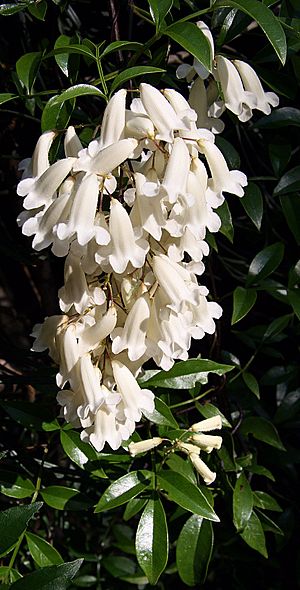Wonga wonga vine facts for kids
The wonga wonga vine (Pandorea pandorana) is a type of woody climbing plant. It belongs to the Bignoniaceae family, which includes many flowering trees and vines. You can find this plant growing in Australia, parts of Malesia (like Indonesia and Papua New Guinea), and islands in the southwestern Pacific Ocean.
This vine grows pointed seed pods that are filled with many light, papery seeds. These seeds are easy to grow. The wonga wonga vine is a very popular plant for gardens. Some common types grown in gardens include 'Golden Showers' (which has yellow flowers), 'Snowbells' (with white flowers), and 'Ruby Belle' (which has pinkish flowers).
Quick facts for kids Wonga wonga vine |
|
|---|---|
 |
|
| Scientific classification | |
| Genus: |
Pandorea
|
| Species: |
pandorana
|
Contents
About the Wonga Wonga Vine
The wonga wonga vine can grow in different ways. It might be a scrambling plant that spreads out, or a strong vine that climbs up larger trees in forests. It has shiny green leaves that grow in pairs along its stems.
What the Plant Looks Like
The leaves are usually about 8 to 16 centimeters (3 to 6.5 inches) long. Each leaf has several smaller leaflets, usually 3 to 9 of them. Young plants have finer leaves with jagged edges, and these leaves are often divided into more leaflets (7 to 13).
The flowers usually bloom in spring. They are shaped like tubes or funnels and come in many different colors. You might see cream-white, pure white, burgundy, or even yellow-orange flowers. Some have a maroon color inside the throat of the flower.
After the flowers, seed pods grow in summer. These pods are oblong-shaped and are about 3 to 8 centimeters (1.4 to 3.4 inches) long and 1 to 2 centimeters (0.4 to 0.8 inches) wide. They start out bright green and then turn brown. When they open, they release many papery seeds, each about 1 to 1.5 centimeters (0.5 inches) across.
Where the Plant Grows
The wonga wonga vine is found all over Australia, in every state. It also grows in countries like Indonesia, Papua New Guinea, the Solomon Islands, New Caledonia, and Vanuatu. It can grow in many different places, from wet rainforests to dry forests and rocky areas. It can even grow in both clay and sandy soils.
In New Zealand, this plant has started to grow wild in disturbed areas near parks and gardens where it is planted.
History and Uses
The wonga wonga vine was first described by a botanist named Henry Cranke Andrews in 1800. Later, in 1928, it was given its current scientific name, Pandorea pandorana, by Steenis. Both parts of its scientific name come from the Greek myth of Pandora.
Traditional Uses
The flexible wood of the wonga wonga vine was very important to the Aboriginal people of the Central and Western Deserts in Australia. They used it to make spears that were thrown with a special tool called a woomera. Because the wood was so flexible, they could even join shorter pieces together if they couldn't find a long one. This plant was so important that a group of mythical women with flexible bodies were named after it.
Growing the Wonga Wonga Vine
The wonga wonga vine was first grown in England in 1793. It became popular because of its beautiful flowers. It is an evergreen plant, meaning it keeps its leaves all year. It can handle cold temperatures down to about minus 5 degrees Celsius once it's grown.
This plant is a twining vine, and its leaves are especially pretty when the plant is young, looking almost like ferns. You can plant it indoors or outdoors. Because it grows quickly, you need to trim it regularly so it doesn't take over other plants in a small garden. The plant likes a lot of sun, but it can also grow in partial shade. Many people believe that the more sun it gets, the more flowers it will produce.
You can grow new wonga wonga vines from fresh seeds, by layering (where a stem grows roots while still attached to the parent plant), or from cuttings. In Australia, this plant is suggested as a good native alternative to the invasive garden climber called Black-eyed Susan (Thunbergia alata).
Popular Types of Wonga Wonga Vine
There are several different types of wonga wonga vine grown in gardens, each with unique flower colors:
- P. 'Golden Showers' has yellow flowers with a hint of brown. It blooms for a long time and grows strongly.
- P. 'Ruby Belle' has red-pink flowers with a creamy center.
- P. 'Ruby Heart' has cream-colored flowers with a deep ruby-maroon blotch in the middle.
- P. 'Snowbells' (also known as P. 'alba') is a strong-growing type with cream-white flowers that have a lovely smell and bloom in large numbers.
Images for kids



